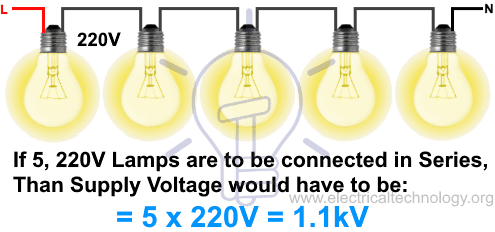Disadvantages of Light Bulbs and Lamps Connected in Series?
Series connection for household wiring like fans, switches, light bulbs etc. is not a preferred way instead of parallel or series-parallel wiring due to serious disadvantages and flaws as described below.
- If breaks occurs in any part of the circuit, no current will flow and the entire circuit become useless (whole lamps and connected devices will go OFF).

Disadvantages of Light Bulbs & Lamps Connected in Series? - A high supply voltage is required if the lamps (or other electrical devices) are to be connected in series because voltage across each connected light bulb are additive (shared) in series circuit i.e. VT = V1 + V2 + V3 +…. Vn. If we add more light bulbs in the series circuit, Its mean more resistance because resistance is also additive in the series circuit i.e. RTotal = RT = R1 + R2 + R3 + …Rn. This way, It would not be possible for the light bulbs to get the exact rated voltage. So we will have to increase the supply voltage for efficient system.

Disadvantages of Series Lighting Circuit - It is not possible to turn OFF or ON a light bulb or any other appliances connected in series circuit. To switch OFF the single light bulb, The whole circuit will be go OFF.
- Two or more light bulbs connected in series would be dimmer than the usual because resistance increases and voltage are shared across the bulbs (low voltages for other bulbs) as compared to single bulb in series as mentioned above. In simple words, current and voltage is reduced due to high resistance and shared voltages in series circuit.
- If the rating of bulbs are different (i.e. Bulb 1 = 60W and Bulb 2 = 100W), the bulb with higher resistance would glow brighter and the other one dimmer. As brightness depends on current and voltage. The bulb which dissipate more power will be brighter i.e. high resistance bulb 1 will dissipate more power and bulb 2 would be dimmer then. (R = V/I = Ohm’s Law).
- Therefor, series wiring connection is not suitable and practicable for lighting circuits.
Connecting lighting points in series has several disadvantages:
- Single Point Failure: If one light bulb fails or is removed, all the other lights in the series will also turn off. This can be inconvenient and potentially dangerous if the lights are needed for safety or security reasons.
- Voltage Drop: As more lights are added to the series circuit, the total resistance increases, which leads to a higher voltage drop across the circuit. This can result in dimmer lights further down the series.
- Complexity: Wiring lights in series can be more complex than wiring them in parallel, especially in larger installations. It requires careful calculation of the total resistance and voltage drop to ensure proper functioning of all lights.
- Maintenance Challenges: Troubleshooting and replacing faulty bulbs in a series circuit can be more difficult and time-consuming than in a parallel circuit, where only the individual bulb needs to be checked or replaced.
- Uneven Brightness: Due to the voltage drop across the series circuit, lights further down the line may be dimmer than those closer to the power source. This can result in uneven lighting distribution.
- Compatibility Issues: Some types of lighting, such as LEDs, may not work well in a series circuit due to their specific voltage and current requirements.
Good to Know: For efficient operation, only those lamps or devices should be connected in series that have the same current rating. however, electrical devices (e.g., heater, toaster, grinder, lamp etc.) have different current ratings. obviously, they cannot be connected in series for efficient operation.
Related Posts:
- Which Bulb Glows Brighter When Connected in Series and Parallel & Why?
- Why Does the High-Wattage Bulb Glow Dimmer in a Series Circuit?
- Which Bulb Glows Brighter When Connected in Series and Parallel and Why?
- Introduction to Series, Parallel and Series-Parallel Connections
- Series, Parallel and Series-Parallel Connection of Batteries
- Difference Between Series and Parallel Circuit – Comparison
- How To wire Light bulbs in Series?
- How To wire Light bulbs in Parallel?
- How To Wire Switches In Series?
- How To Wire Switches in Parallel?
 What is the Difference Between AC Ground and DC Ground?
What is the Difference Between AC Ground and DC Ground? Should You Connect GND and 0VDC? Combined AC & DC Grounding
Should You Connect GND and 0VDC? Combined AC & DC Grounding Can you Combine AC and DC Ground in a Solar Installation?
Can you Combine AC and DC Ground in a Solar Installation? Why Doesn’t DC System Require a Grounding System Similar to AC System?
Why Doesn’t DC System Require a Grounding System Similar to AC System? How to Calculate the Floor Area For General Lighting?
How to Calculate the Floor Area For General Lighting? How to Determine the Number of Lighting Branch Circuits?
How to Determine the Number of Lighting Branch Circuits?